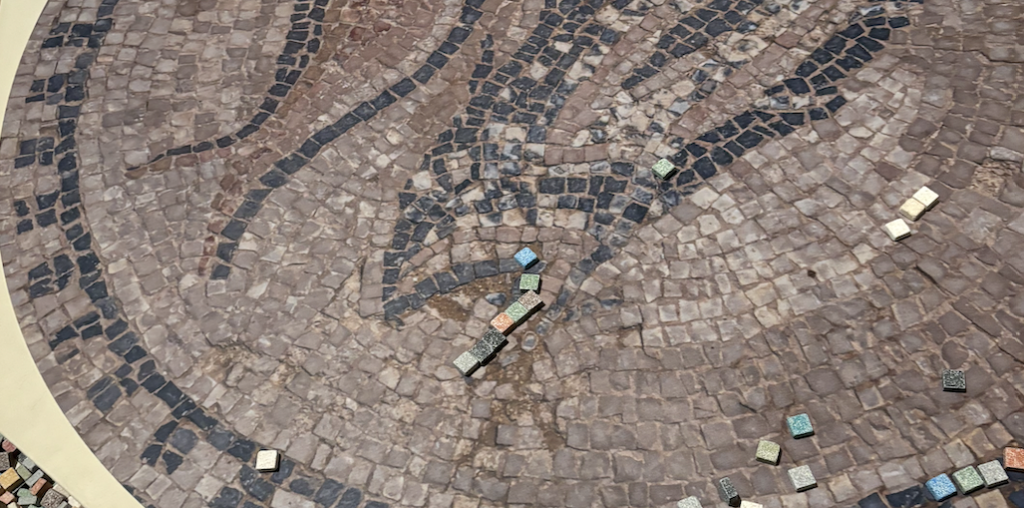
While the museum is not highlighting its seven-year anniversary with any grand plans, some visitors to the mosaic find the seven-year timing biblical.
“The numbers 7, 12 and 40 are special in the Bible and seven is the biblical number of completion,” noted the Rev. Samuel Wilson, a pastor Des Moines, Iowa, who strolled into the mosaic exhibit alone on a balmy November day in a short-sleeve shirt. “Genesis says God rested on the seventh day.”
Wilson is one of more than three million visitors to the 430,000-square-foot museum since it opened following $400 million purchase and renovation project of the building just two blocks from the National Mall. The 1923 building once served as a railroad refrigeration facility and Washington Design Center, a furniture warehouse.
The museum is home to 40,000 artifacts and exhibits and has had its share of questions about looted art, but the Megiddo Mosaic is on official loan by the Israel Antiquities Authority in partnership in partnership with the Israel Antiquities Authority.
The Museum of the Bible prides itself on its non-sectarian posture and visitor Jane Cohen found the approach fresh, she said.
“As a Jew, I appreciate the attention to Jewish subject matter,” she said, adding that she likes the grandeur, elegance and spacious of the museum and the exhibits. “It’s thoughtful, not preachy.”
John Teneyck, an intern and volunteer manager, is not shy about sharing the Bible, including his favorite verse — Psalm 56: 3-4 — which says not to be afraid but trust in God, but he said the museum doesn’t exist to proselytize.
Campo noted the same.
“We believe that the Scriptures are relevant to every society, and do our best to maintain a neutral, nonsectarian stand as we allow the word of God to speak for itself,” he said. “This is always a challenge, because there is a natural tendency for outside parties and even some internal groups to want personal expressions or views be asserted in addition to what the word of God says. We do our best to avoid those approaches and just let the Bible speak for itself.”
While the museum approaches a neutral posture, the Megiddo Mosaic has a strong message for the early church. The mosaic dates to the year 230 A.D. when the Roman Empire outlawed Christianity. The tiles tell the story of faith a Roman centurion, Gaianus, who called “our brother” in the mosaic that praises him for his generosity in underwriting the worship place.
Another inscription recognizes the artist, Brutius, and four women who may have been martyrs, along with Akeptous, who donated the stone table, which historians suspect was the foundation for a wooden altar used for the Eucharist.
Akeptous is called philotheos, which means “God lover.” The most arresting inscription on the faded tile is the phrase that the table was dedicated to “God Jesus Christ.”
“This dedication is now the earliest archaeological evidence of Jesus being called God,” according to the historians associated with the mosaic’s installation.
Among the odd facts about the Megiddo Mosaic are that it was found at a maximum-security prison in region of Galilee in the Roman province of Syria-Palestine where Romans, Jews, Samaritans, Christians and others lived. Also known as the Jezreel Valley, the area is sometimes referred to as Armageddon and served as a military site for thousands of years, according to museum historians.
According to historians, excavations reveal that people often baked bread in the outer courtyard near the mosaic at Kefar ‘Othnay. The exhibit includes a place where visitors can emboss a piece of paper like a baker who would want soldiers to know he baked the bread.
The symbol of the museum is reminiscent of baked bread and resembles an art deco toaster.
Visitors also can try their hand at using tiles the size of a penny to recreate the elaborate fish inscription on the mosaic, an early sign of Christianity.
During this period, crosses weren’t used to designate Christians, noted Debbie Ramsey, VIP Relations associate.
“Crosses were a negative image,” she said of that historic period, adding that the fish was a common representation.
The structure, about 20-by 30-feet, was modest and Ramsey said it could not hold a very large crowd of people but its purpose appears to be a place for worship, particularly for communion services
The Museum of the Bible is open daily from 10 a.m. to 5 p.m. It is closed on Thanksgiving, Christmas and New Year’s Day. It closes at 4 p.m. on Christmas Eve. For more information, visit www.museumofthebible.org.

